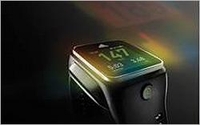
Sports gear makers are becoming purveyors of high-tech wrist wizards. Nike's FuelBand, New Balance Lifetmr, and Under Armour's Armour39 watch and bluetooth-linked
heart monitor. Adidas is latest to market with its second-generation Smart Run. The $399 machine, which hit shelves Nov. 1, is as much like a smartphone as a watch (minus the phone).
Marketing
Daily talks clocks with Adidas designer Paul Gaudio.
Q: What are table stakes in sports watches? How did you address the need to get ahead on that?
A: It has
to be extremely comfortable, really pliable and and really light, and then the interface: full-color display with touchscreen, which is different from most products on the market. It's not just a
screen filled with numbers; but we can give a customizable graphic interface. And we can deliver far more sophisticated content through the product.
advertisement
advertisement
Q: Beyond the metrics
measurement, what is that content?
A: We have an integrated "engine" behind it, miCoach, which is really about turning insights into an action plan. And it all happens on the
watch, with functionality in the cloud, so I can communicate back and forth wirelessly with the network and download such content as customized training plans. I get real-time data while running and
can review statistics and performance after the run, and can also view my workout history on the watch, a smartphone or the Web if I want a more detailed view.
Q: When you create a
product like this, from what other categories do you get insights?
A: We looked at a ton of products, but I think the smartphone was influential. The traditional sports watch
world is still old school and digital. Taking a touchscreen approach, for example, allowed us to create a more intuitive interface.
Q: But the smartphone category means short product
cycle. How do you stay ahead?
A: Well, it's not a static product. We can do frequent updates, whether it's a new feature or function. We can add to the experience. We have to keep
in mind the three-year cycle from the hardware perspective, but the software is something we are always updating. Not only do our competitors come up with new things, but our users are giving us
feedback all the time. We want to be able to respond to that.
Q: Watches seem like the next convergence space, integrating smartphones, chat, video, etc. on your wrist. Should Smart
Run have some of that?
A: We try to make sure we are focused on our consumer, so rather than saying 'now we need to put a SIM card in it and ad telephone-call function,' we have to
stay focused on runners. We are fitness-minded and our customer has those goals. So it's a consumer-driven -- not technology-driven -- product.
Q: Does all of this mean traditional
sports gear and apparel companies becoming consumer electronics companies?
A: I think think, more and more, we are using technology to better the performance experience. But if you
look around at any brand in any business you are seeing increasingly use of technology. It doesn't make us a technology company per se; we are still focusing on providing serves and technology to
consumers in much more connected way. It helps us to do a better job.